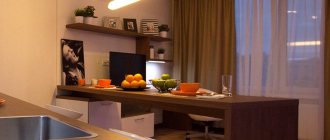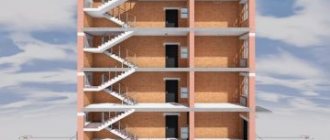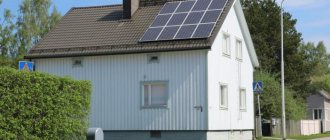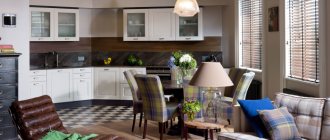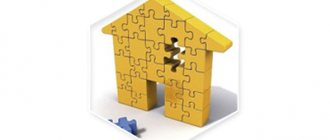Non-residential premises in an apartment building - what is it?
Legally, this concept is defined by Government Decree No. 354 of May 6, 2011 “On the provision of utility services to owners and users of premises in apartment buildings and residential buildings” and states that non-residential premises in an apartment building are premises that cannot be classified as the common property of the owners of the premises in the house.
The difference between residential and non-residential premises in apartment buildings is their intended use . Non-residential buildings are used exclusively for commercial, administrative or public needs; their use for permanent residence is strictly prohibited. For example, non-residential premises are used as offices, shops and service points.
The concept of built-in non-residential premises also applies to MKD. In many buildings, spaces for commercial infrastructure are designed immediately, therefore, despite the lack of definition of built-in and attached premises in the Codes of the Russian Federation, they can be found in Appendix B to the Code of Design and Construction Rules “Architectural and planning solutions for multi-apartment residential buildings” (SP 31-107 -2004).
According to this document, a built-in non-residential premises is a premises located within the dimensions of a residential building and protruding beyond its boundaries by no more than one and a half meters.
Is the attached non-residential premises part of the house?
Additional premises are added to many residential apartment buildings, most often for non-residential purposes. If such a building is located at some, albeit small, distance from the house, then everything is clear - a separate building. But how is it taken into account if such an object is closely adjacent to the house?
This is important to know: How to evict your ex-wife from an apartment
The answer in this case is quite simple - if the building is closely adjacent to the MKD (apartment building) and, based on the data from the technical passport and other documents, is part of the general structure, then it is taken into account as part of the MKD, with all the ensuing consequences. The opposite is also true.
Requirements for such areas in MKD
The basic requirements are based on the basic principle of preserving and maintaining comfortable living conditions for residents:
- The premises must comply with sanitary, urban planning and fire safety standards.
- A separate entrance is required. Sharing entrances with residents is prohibited.
- Location on the ground floor of the building or in the basement. If the premises are located on a floor above the first, then all premises below must also have non-residential status.
- Lack of registered and resident persons.
- Any activity that could cause harm to residents, as well as production that violates noise and pollution standards, is prohibited.
- The presence of all utilities is also a mandatory requirement.
- Having clear boundaries and a legal owner.
When purchasing real estate for specific purposes, carefully read all the technical documentation to see if it is possible to use this premises for your needs.
How to become the owner of non-residential premises in an apartment building
A problem that often arises is that there is a buyer for the premises, but it is not clear who will sell it. In such a situation, it is worth focusing on the extract from the Unified State Register of Real Estate, since anyone can receive it and, based on this, take some specific actions. There are three main options in total. Let's look at them all.
This is important to know: The act of accepting the transfer of an apartment under the DDU
Ransom
The simplest scheme. The premises have a specific owner: an individual or legal entity. Most often this is a developer. You can directly buy this or that premises from him, after which you can rebuild it and use it for your own purposes. For example, to create the same store.
This option is especially relevant if the premises are located on the ground floor and were originally planned for commercial activities. This is often found in modern new buildings.
Privatization
This option is more relevant for old houses. Many of the premises in them may belong to the state/municipality. As a result, in order to register ownership of them, they must first be privatized. This is quite difficult to do. Moreover, unlike residential real estate, the privatization of non-residential premises is a paid procedure.
The cost of an object may be slightly less than its price on the market, but this is not a mandatory rule. In practice, most of these premises have already been privatized for the purpose of further resale at market prices or for personal use.
Withdrawal from housing stock
This option is currently very common. A company or individual entrepreneur buys a residential apartment located on the ground floor, after which it changes its status, turning residential property into non-residential property. To do this, he needs to obtain the consent of the majority of apartment owners in the apartment building and, very importantly, absolutely all the neighbors whose premises are directly adjacent to the target property.
FREE CONSULTATIONS are available for you! If you want to solve exactly your problem, then
:
- describe your situation to a lawyer in an online chat;
- write a question in the form below;
How to find out the size?
Most often, confusion occurs in the concepts of common and non-residential property. Common areas include:
- basements;
- elevator areas;
- attic;
- stairs.
Mathematically, the formula for the area of non-residential spaces in a house can be expressed as follows:
The total area of the house minus the common area minus the residential area.
The remaining part will be the desired value.
To find out the area of residential and non-residential premises in an apartment building, you need to refer to an extract from the Unified State Register of Real Estate, which provides accurate data on buildings registered in the cadastral register. Also, this data is indicated in the technical passport of the building, which can be viewed in the HOA or by carefully studying the receipt for payment for services. It indicates the area of premises of each type.
Room sizes
The area of the entire house includes the area of all apartments and the common area. The latter includes elevators, landings, basements, attics, etc. Their parameters are reflected in the technical passport, which is stored in the management company or in the HOA. Calculating the area is important when determining the amount of payment for utilities, in particular heating.
This is important to know: Transactions with communal apartments
The size of non-residential premises is formed from the areas of all internal sections. Balconies and loggias are not taken into account. When determining their areas, reduction factors are used.
How to obtain ownership of this territory?
The easiest option for obtaining such property is to purchase a premises with already registered status from the developer or owner. Options for obtaining ownership can also be an exchange transaction, privatization, donation, inheritance or any other method of alienation of the right of ownership of the previous owner.
However, most often there is initially a residential apartment on the ground floor, which must first be registered as non-residential, and then obtain registration of ownership.
What law is it regulated by?
The grounds for acquiring property rights are discussed in Article 218. Civil Code of the Russian Federation. Changing the category of housing is regulated by the Housing Code of the Russian Federation, in particular, Art. 22 and art. 23. Real estate transactions are also controlled by Federal Law No. 218 “On state registration of rights to real estate.”
How to become an owner: step-by-step instructions
A step-by-step algorithm of actions with a list of necessary documents and approximate deadlines for the implementation of each stage:
- Preliminary analysis . Initial assessment and inspection of the building, analysis of the technical or electronic passport of the house, creation of a redevelopment plan. It takes 14-20 days.
- Obtaining the consent of all homeowners. This can be done at a regular or extraordinary general meeting. To convene an extraordinary meeting, you will have to submit an application to the management company and notify each home owner in writing at least 10 days before the meeting.
The meeting will be considered valid if at least 50% of the property owners are present, and the decision to change the status of the premises will be legitimate if at least 75% of those present agree.The final document required in the future is the minutes of the meeting. Taking into account the interval for preliminary notification and the time for coordinating the fee with the HOA, this stage can take up to 30 days.
- Coordination of the redevelopment project and arrangement of the entrance group . It is necessary that the reconstruction project be agreed upon with regulatory and supervisory authorities, such as the Committee on Urban Planning and Architecture, the Committee on Landscaping, etc. The longest stage of the process can last 5-6 months.
- Transfer to non-residential property. A prepared package of documents must be submitted to the local government body. After submission, the applicant is given a receipt with a list of documents and the date. The period for considering the application and making a decision should not exceed 45 days, after which the applicant should receive a response within 3 business days.
The list of required submissions includes:- application for transfer of premises;
original or notarized copies of title documents;
- a coordinated and correctly completed reconstruction project;
- minutes of the meeting of owners, confirming the fact of general agreement (clauses 6, 7, part 2, article 23, introduced by Federal Law No. 116 of May 29, 2019;
- floor plan of the house and technical certificate of the premises.
- Putting the facility into operation and obtaining property documents. The final stage consists of receiving a signed act of putting the object into operation after acceptance by the commission in charge of the alienation of real estate, contacting the BTI and MFC, making changes to the Unified State Register and can last 30-60 days.
This list of documents is regulated by law in Part 2 of Art. 23 of the Housing Code of the Russian Federation. The requirement to provide any other additional documents is unlawful.Works and services that entail financial costs:
- Ordering technical documentation from BTI.
- Work of a notary, involved intermediary law firms.
- Construction works.
- Payment of the state duty for registering property rights in Rosreestr. In accordance with the Tax Code of the Russian Federation in 2021, it is 2,000 rubles for individuals and 22,000 rubles for legal entities.
Design office services for creating a redevelopment plan.
The minimum cost will be 250,000 rubles. In large cities, costs can increase 2-3 times.
Requirements for non-residential premises in an apartment building
Non-residential premises suitable for commercial activities and located in an apartment building must meet certain requirements. There are a lot of them. The main and most important ones will be listed below, but it is still better to trust a specialist to draw up a plan for arranging the premises.
Fire safety
If we summarize all the rules and regulations of SNiP 21-01-97, then an approximate list of requirements will look like this:
- The premises must comply with the design documentation.
- The premises must provide for the possibility of evacuation and access for firefighters.
- The room must be equipped with smoke extractors and a fire extinguishing system.
- An evacuation plan must be posted in a visible place.
- Any restructuring/redevelopment or reconstruction must be carried out strictly according to a pre-approved project.
Specific requirements for the placement of fire extinguishing systems, emergency exits, structural elements, and so on depend on many factors.
Sanitary and environmental
In addition to fire safety requirements, owners of non-residential premises in apartment buildings are also required to take into account sanitary, hygienic, and environmental requirements:
- The entrance to non-residential premises must be separate, not connected with the entrances and exits used by residents of the apartment building.
- The heating system must heat the air evenly without creating foreign odors, noise or polluting the air. All elements of the heating system must always remain accessible for maintenance and repair.
- The temperature difference between the air in the room and its walls/ceiling should not be more than 2-3 degrees.
- Ventilation of premises can be combined with general ventilation for the house, but only if the air is not polluted with harmful substances. Otherwise, a non-residential property must have autonomous ventilation.
- Permissible constant level of infrasound: bands 2.4, 8 and 16 Hz.
- Electromagnetic radiation: up to 300 GHz.
- The maximum level of gamma radiation inside a building cannot be greater than the general background by 0.2 µ3v/hour.
Liability for misappropriation
The Criminal Code of the Russian Federation stipulates 2 elements of malicious crime, which can be regarded as misappropriation of someone else's property: misappropriation (Article 160 of the Criminal Code) and arbitrariness (Article 330 of the Criminal Code). The resulting liability will depend on the severity of the crime and the presence or absence of aggravating circumstances.
The maximum possible types of negative consequences:
- Payment of a fine of up to 500,000 rubles or the total earnings of the invader for six months.
- Mandatory correctional labor up to 480 hours.
- Correctional labor for up to 2 years.
- Forced labor for up to 5 years, with possible restriction of freedom for up to 1.5 years.
- The term of imprisonment is 5, 6 or 10 years.
Non-residential commercial premises today are part of almost every apartment building. The main theses and concepts that both property owners and business people need to know were discussed in the article. However, legislation tends to change over time, so if you have any questions or doubts, you should contact a specialist.
How to manage non-residential premises in an apartment building
Owners of real estate in apartment buildings that are not intended for residential use are not parties to the agreement between the apartment owners and the management organization (MC). They must independently register with utility organizations and sign an agreement with them.
If the owners of non-residential premises for some reason have not concluded an agreement with utility organizations, then the head of the management company or the chairman of the HOA must report the availability and quantity of non-residential premises to the relevant resource supply and service organizations.
How can you use non-residential premises in an apartment building?
Taking into account the above, as well as all other requirements, rules and regulations, we can draw up an approximate list of commercial facilities that can be located in non-residential premises of an apartment building:
- All kinds of small offices and branches of various companies.
- Outlets.
- Beauty Salons.
- Pharmacies and medical institutions.
- Photo studios.
- Atelier for tailoring clothes/shoes.
- Communications departments.
- Restaurants, cafes, bars and other similar establishments.
- Educational facilities (private kindergartens, schools, etc.).
- Exhibition halls.
- Warehouses and so on.
In general, almost anything can be placed in an apartment building, but only on the condition that such objects will not interfere with surrounding residents, will not harm health, and so on. If these requirements are met, then no special claims will be made against the owner of such real estate.

